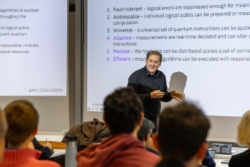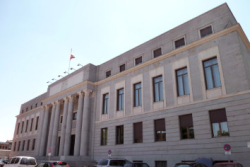
The Spanish National Research Council (CSIC) – a central institution of the Ministry of Science – has awarded Peter Zoller a visiting professorship, known as a JAE Chair. As part of this collaboration, the theoretical physicist will work with colleagues at the CSIC-Instituto De Física Fundamental on a project focusing on quantum technologies.
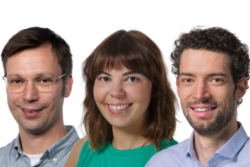
The Austrian Science Fund (FWF) has approved a new special research area on quantum systems of neutral atoms. Research groups led by Hannes Bernien, Francesca Ferlaino, and Hannes Pichler from IQOQI Innsbruck are participating in this project. The FWF will fund the new research network with approximately €4 million over a period of four years.
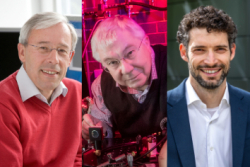
Every year, the data company Clarivate publishes a list of the most cited—and therefore most influential—scientists. The latest list, published on Wednesday, includes 6,868 “Highly Cited Researchers” from 60 countries—3 of whom are from IQOQI Innsbruck: Rainer Blatt, Hannes Pichler, and Peter Zoller.
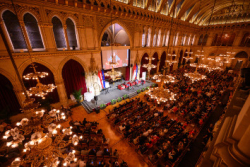
Austria is a real hotspot on the international quantum physics map. To mark the end of the UNESCO Year of Quantum Theory, the Austrian physics community celebrated the achievements of its research and invited the public to an event at Vienna City Hall under the motto “Welcome to the Quantum World.”
It was without question the quantum party of the year: on November 6, the Austrian research community celebrated 100 years of quantum physics. Around 800 guests from the worlds of science, politics, business, and society gathered at Vienna City Hall to celebrate 100 years of quantum science—and to honor Austria's role as an international quantum hub.
Comedians Stermann & Grissemann proved that science in general, and quantum physics in particular, don't have to be deadly serious. They brought quantum physics to the stage in an original way during their performance, interviewing leading figures in quantum research such as Francesca Ferlaino (IQOQI/University of Innsbruck), Thomas Juffmann (University of Vienna), and Marcus Huber (IQOQI/TU Vienna). Afterwards, young researchers – among them Arfor Houwman and his team from the Ferlaino lab – thrilled the audience with a “quantum science slam.”
UNESCO Year of Quantum Physics
Exactly one hundred years ago, mathematical formulas were used for the first time to explain the behavior of quantum particles. That is why UNESCO has declared 2025 the International Year of Quantum Physics. One of the pioneers of quantum theory at that time was the Austrian researcher Erwin Schrödinger, who wrote down his famous Schrödinger equation. And Austria still has a lot to offer in this field today: a whole series of research groups from all over Austria have established themselves at the forefront of global research.
The event “Welcome to the Quantum World” was organized by the FWF-funded Cluster of Excellence “Quantum Science Austria” (quantA) in cooperation with the City of Vienna. Quantum Science Austria consists of 70 research groups at six institutions working on the fundamentals and applications of quantum physics.
At the opening ceremony, ÖAW President Heinz Faßmann also highlighted this cross-institutional collaboration as a successful model for domestic quantum physics: “It enables us to present a harmonious image to the outside world and engage in fair competition internally.”
Questions and answers for everyone
Following the entertainment program at “Welcome to the Quantum World,” there was plenty of opportunity for an exchange of ideas: experts answered guests' questions about quantum theory and quantum technology in an informal setting. Researchers, start-ups, representatives from politics and research funding, and also the Atom:innen network project were present.
